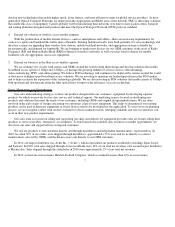Adaptec 2010 Annual Report Download - page 15
Download and view the complete annual report
Please find page 15 of the 2010 Adaptec annual report below. You can navigate through the pages in the report by either clicking on the pages listed below, or by using the keyword search tool below to find specific information within the annual report.
potential trade barriers or regulations, uncertain protection for intellectual property rights and generally longer receivable collection
periods. In addition, fluctuations in foreign currency exchange rates could adversely affect the revenues, net income, earnings per
share and cash flow of our operations in affected markets. Similarly, fluctuations in exchange rates may affect demand for our
products in foreign markets or our cost competitiveness and may adversely affect our profitability.
Our results of operations are increasingly dependent on our sales in China, which on a bill-to basis, accounted for over 34% of
our net revenues in 2010 compared to 40% of our revenues in 2009. Government agencies in China have broad discretion and
authority over all aspects of the telecommunications and information technology industry in China; accordingly their decisions may
impact our ability to do business in China. Therefore, significant changes in China’s political and economic conditions and
governmental policies could have a substantial negative impact on our business. While the growth of Fiber-To-The-Home technology
in China has continued to be strong, a slowdown in that growth would have an adverse impact on our operating results.
In addition to selling our products in a number of countries, an increasing portion of our research and development and
manufacturing is conducted outside North America, in particular, in India and China. The geographic diversity of our business
operations could hinder our ability to coordinate design, manufacturing and sales activities. If we are unable to develop systems and
communication processes to support our geographic diversity, we may suffer product development delays or strained customer
relationships.
The loss of key personnel could delay us from designing new products.
To succeed, we must retain and hire technical personnel highly skilled at design and test functions needed to develop high-speed
networking products. The competition for such employees is intense.
We do not have employment agreements in place with many of our key personnel. As employee incentives, we issue common
stock options and restricted stock grants that are subject to time vesting, and, in the case of options, have exercise prices at the market
value on the grant date. As our stock price varies substantially, the equity awards to employees are effective as retention incentives
only if they have economic value.
Our revenues may decline if we do not maintain a competitive portfolio of products or if we fail to secure design wins.
We are experiencing significantly greater competition in the markets in which we participate. We are expanding into market
segments, such as the Wireless, and Fiber and Radio Access market segments, which have established incumbents with substantial
financial and technological resources. We expect more intense competition than that which we have traditionally faced as some of
these incumbents derive a majority of their earnings from these markets.
We typically face competition at the design stage, where customers evaluate alternative design approaches requiring integrated
circuits. We often compete in bid selection processes to achieve design wins. These selection processes can be lengthy and can
require us to invest significant effort and incur significant design and development expenditures. We may not win competitive
selection processes and even if we do win such processes, we may not generate the expected level of revenue despite incurring
significant design and development expenditures. Because the life cycles of our customers’ products can last several years and
changing suppliers involves significant cost, time, effort and risk, our failure to win a competitive bid can result in our foregoing
revenue from a given customer’s product line for the life of that product.
The markets for our products are intensely competitive and subject to rapid technological advancement in design tools, wafer
manufacturing techniques, process tools and alternate networking technologies. We may not be able to develop new products at
competitive pricing and performance levels. Even if we are able to do so, we
14
























